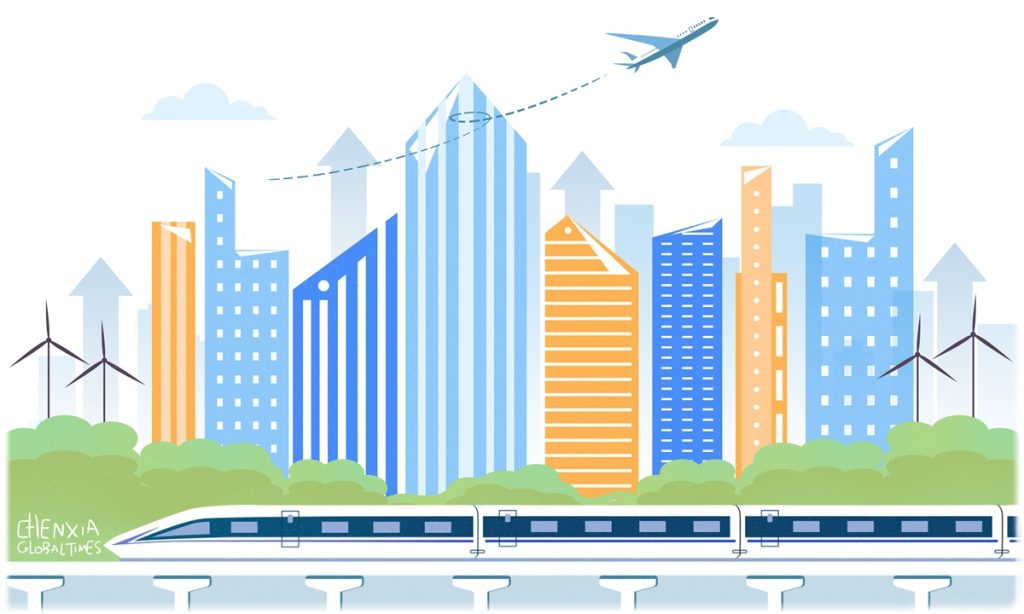
Illustration: Chen Xia/GT
Recently, China’s Ministry of Finance, together with the National Development and Reform Commission (NDRC), has earmarked 300 billion yuan ($41.8 billion) in ultra-long special treasury bond funds to back the consumer goods trade-in program. With this round of funding, this year’s project list for major national strategies and security capacity building in key areas, totaling 800 billion yuan, has been fully issued.
A wave of large-scale “hard investment” projects is being rolled out in an orderly manner, alongside “soft infrastructure” efforts such as planning, institutional reforms and mechanism innovation – all emerging as key drivers of high-quality development. China’s domestic infrastructure is entering its own “DeepSeek moment” – a turning point toward rapid advancement. Amid a complex and volatile global and domestic economic landscape, the infrastructure sector is seizing a rare window of opportunity to leap forward.
The NDRC has committed 800 billion yuan to supporting 1,459 projects across key areas. The central government’s financial subsidies for urban affordable housing projects in 2025, amounting to 56.6 billion yuan, focus on renovating old residential communities and building high-standard farmland. Overall, the 2025 program for major national strategies and security capacity building in key areas is expected to directly drive about 1.6 trillion yuan in fixed asset investment – a powerful tool to counter downward pressure from the real estate sector.
Infrastructure should not be seen as the ultimate goal, but rather as a tool to facilitate social development. Real demand from society must be the guiding principle for infrastructure’s growth. Implementation of projects for major national strategies and security capacity building in key areas, including old city renovation and urban renewal efforts, are already underway. At the same time, urgent needs remain in urban road safety projects, dedicated transportation corridors for passengers and freight, rural water conservancy systems, county-township-village sewage treatment networks, and the construction of public and sports facilities in rural areas, among other areas.
National economic growth typically follows four stages: factor-driven, investment-driven, innovation-driven and wealth-driven. China’s infrastructure sector has already passed through the large-scale, government-led investment and is now undergoing a transition from investment-driven growth to innovation-driven development. A successful transition will ignite new demand and further upgrade and advance the industry.
A key direction for technological innovation in the infrastructure sector is how traditional infrastructure can integrate with emerging technologies such as 5G communication, artificial intelligence and the Internet of Things. The goal is to overcome harsh environmental constraints and achieve infrastructure that is safer, more comfortable, more efficient, greener and smarter.
Concepts like smart cities, smart railways, smart highways, smart water conservancy and intelligent buildings reflect the industry’s vision for the future. However, the paths toward realizing these goals are still in their early stages. The good news is that China currently leads the world in research and development investment in new infrastructure, and a growing number of pilot projects and technological demonstration initiatives are steadily moving forward.
To adapt to the new stage of development, infrastructure projects must be sustainable. The government has made it clear that municipal infrastructure funded by public investment must strictly follow legal approval procedures, ensure funding sources are in place, strengthen budget discipline and guard against debt risks. The goal is to prevent the waste of public funds and land resources and to avoid future debt burdens. Idle high-speed rail stations and empty subway lines show how poorly planned projects can lead to a serious waste of public resources.
With strong policy support and rising market demand, China’s infrastructure sector is poised for further growth. However, the industry must also recognize that as the national economy enters a more stable phase, meeting regional needs, driving innovation and improving quality will be key to achieving high-quality development – and to seizing China’s “DeepSeek moment” in infrastructure.
The author is a professor at the School of Civil Engineering, Guangzhou University. opinion@globaltimes.com.cn

